Rose Tea Guide
This post may contain affiliate links. Simple Loose Leaf is a participant in the Amazon Associates Program, an affiliate advertising program designed to provide a means for sites to earn advertising fees by linking to Amazon.com. When you need a little bit of beauty in life, relaxing moments and a wonderful flavor in your cup, rose tea is the perfect choice. This beautiful and versatile floral tea may provide numerous benefits and is very easy to brew. Learn more about rose tea and how to make it at home.
What is rose tea?
Rose tea is an infusion made with rose petals or rose buds. Roses have been associated with sophistication, love and beauty for thousands of years. Today, they still carry the same message. Rose tea is no different. It’s one of the most beautiful, aromatic and sophisticated floral teas in the world. Rose tea can be pure or blended with other herbal ingredients or real tea. In fact, roses are often used for scenting real teas, especially in China and India. All teas can be scented with roses – white, yellow, green, oolong, black and dark. There are many types of roses. They belong to the botanical family Rosaceae, same as strawberries, cherries, apples and even almonds. Roses are very important in many traditional cuisines, where they are used for scenting and flavoring many dishes. Pink Rosa Damascena is commonly used for making rose tea. Many other types are used too, usually red and pink colored, but they may be more bitter than Rosa Damascena type[1].After pollination, roses produce rose hips - rose pseudo-fruits used for making herbal tea.Pure floral rose tea or herbal rose blends will always be caffeine free. Rose tea blends with Camellia sinensis or real tea leaves will contain caffeine, so pay attention to which tea you choose if you want to avoid caffeine.
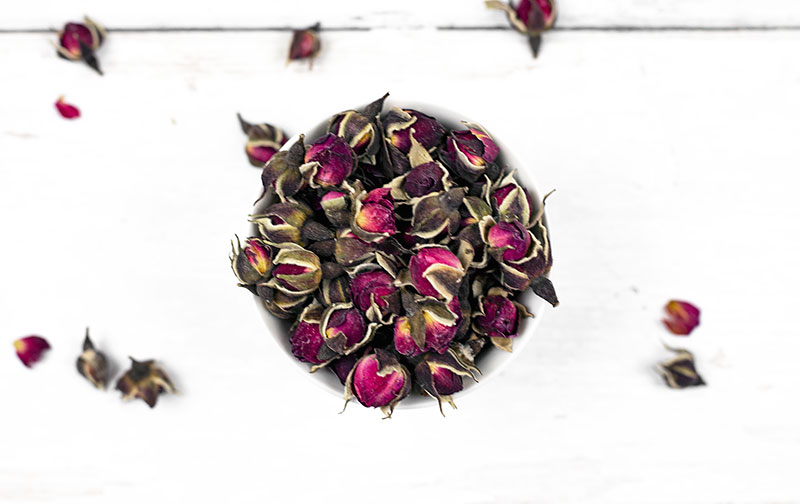
How to make Rose Tea
Roses are not only pretty, they are extremely versatile too. You can brew them hot or cold, use for making iced teas or add them to a water jug to add just a bit of scent to water, add to lattes or desserts. They blend well with almost any type of tea in the world – from mint to rooibos, white or green, and even tangy hibiscus. Although you can use different types of roses for making herbal tea, some will be more sweet, some more bitter. Don’t overbrew your rose tea or it will become too strong. Usually, dried rosebuds or rose petals are used for making tea, although fresh roses can be used too. You can dry them yourself from organically grown roses or buy already dried food-grade rose petals or buds. If you are drying rose petals at home, make sure they are pesticide free and avoid those from supermarkets or florists as they are usually chemically treated.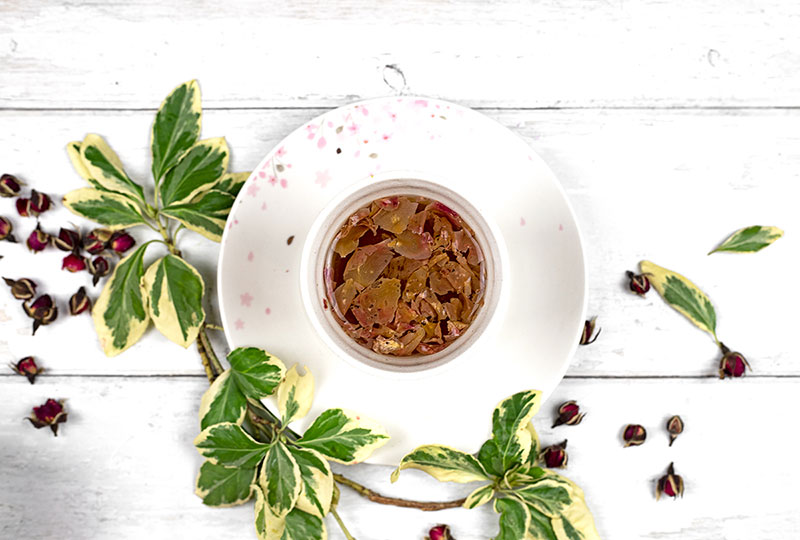
Pure Rose Tea
To make a cup of pure rose tea, use about 1 teaspoon of dry rose petals or 2 teaspoons or dry rose buds. Bring water to a boil and let it cool down for a minute. Steep the petals or buds for 5 minutes. Strain and serve it pure or with a bit of honey. If you want a more delicate flavor, cold-brew them overnight in the fridge. Interestingly, rarely any rose tea will brew into a pink colored drink – most of them will be light yellow brown. Rosebuds will usually release less flavor and color than rose petals – simply because they are tightly closed and won’t be able to expand like petals would. If you want to get the most out of your rose buds tea, gently crush or cut them.Studies showed that 20 minutes brewing time will maximise the free-radical scavenging activity of rose tea[2]. Keep in mind though, the longer the brewing time, the stronger the flavor.
Benefits of Drinking Rose Tea
Rose tea doesn’t only smell and taste delicious, it may provide numerous health benefits too. It contains gallic acid[3], anthocyanins,[4] kaempferol and quercetin.[5] Traditionally, rose tea has been used for aiding digestion, protecting the heart, fighting inflammation and relieving different types of pain. However, many of the potential health benefits are still not scientifically backed up. Rose tea and rose extracts may provide antimutagenic[6], anti inflammatory, antimicrobial and antidiabetic, antioxidant, and antidepressant[7] activity.1. Antioxidant activity
Rose tea is rich in antioxidants. One study showed that rose tea may have a higher free-radical scavenging activity than green tea[8]. However, not all green teas are the same, and not all rose teas are the same. Depending on the type and other factors, they may have higher or lower antioxidant activity. Combined, they may provide a wonderful, antioxidant boosting drink with a delicious taste. In fact, adding a few rose petals to your black or green tea may boost the antioxidant activity even more[9]. Another study showed that tea made from rose petals may have a much higher antioxidant activity than tea made from rose buds[10].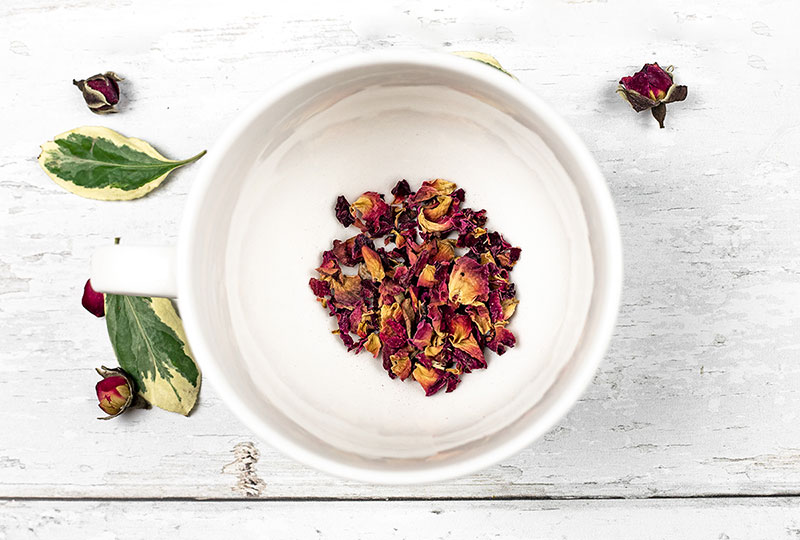
Dried rose petals and rose buds
2. Promoting sleep
Pure rose tea is caffeine-free. That means you can enjoy it even right before sleep. Furthermore, studies showed that some compounds in rose extracts have a hypnotic effect and may be beneficial for inducing sleep[11]. If you really want to treat yourself before going to sleep, try a delicious caffeine free rose latte.3. Protecting the brain and pain relief
Rose extract may help to relieve pain as they provide analgesic effect. But it may provide more than just a hypnotic and analgesic effect. Studies showed that rose extract could potentially prevent seizures and help people with Alzheimers disease[12].4. Treating dysmenorrhea
One of the traditional uses of roses has been treating menstrual bleeding. Studies showed that tea made from roses may indeed, significantly help with treating symptoms of dysmenorrhea including relieving menstrual pain, distress and anxiety[13].5. Weight loss and digestion
Rose petals may help with digestion[14] and provide a slight laxative effect[15]. Therefore, it may help with weight loss goals too. Pure herbal rose tea is calorie free. If you choose to cold-brew dry rose petals, you will be able to enjoy fragrant, but light herbal tea without bitterness.Potential Side Effects
Although drinking rose tea is generally safe, some side effects are still possible, such as allergic reactions. Always consult your doctor before adding new flowers, herbs, plants into your diet, especially if you already have an underlying medical condition.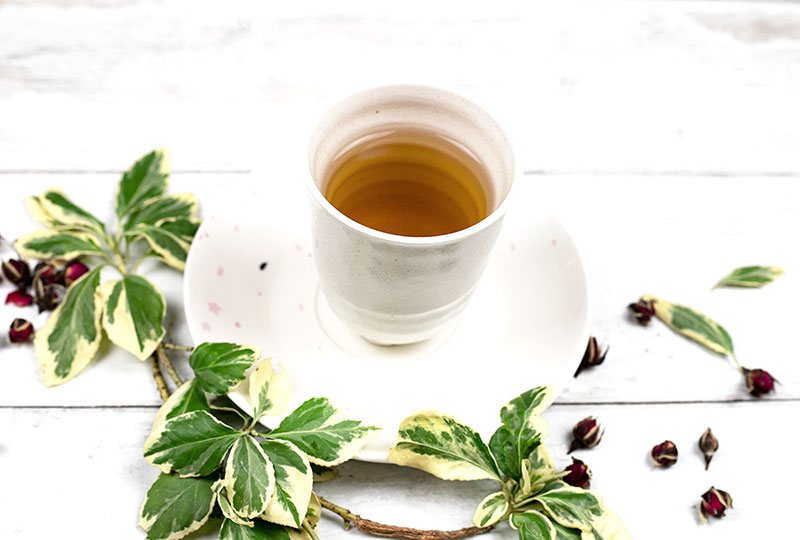
Best Rose Tea Recipe
Roses blend amazingly well with many ingredients. You can use a couple of petals to enhance the flavor of your favorite pure tea or blend them with 2-3 ingredients to create your own special blend. One of the most beloved rose blends in the world is Rose Black Tea blend. For making your own black tea and rose blend, you will need dried rose petals and black tea. If possible, use Grand Keemun or Lapsang Souchong tea as they will provide a wonderful malty and full or slightly smoky base for fragrant rose petals. For one cup of tea you will need:- 1 teaspoon of Grand Keemun tea leaves
- A cup of spring water
- ½ teaspoon of dried rose petals
- Honey (optional)
Best rose blends to try
If pure rose tea is too fragrant for you but you still want to enjoy the benefits and a light rose note in your cup, try the following blends:Rose Grey Black Tea
A blend of roses, lavender and rosemary, and a strong black tea with a signature flavor – bergamot with an elegant soul, a strong character and enough caffeine for a perfect breakfast or afternoon teatime.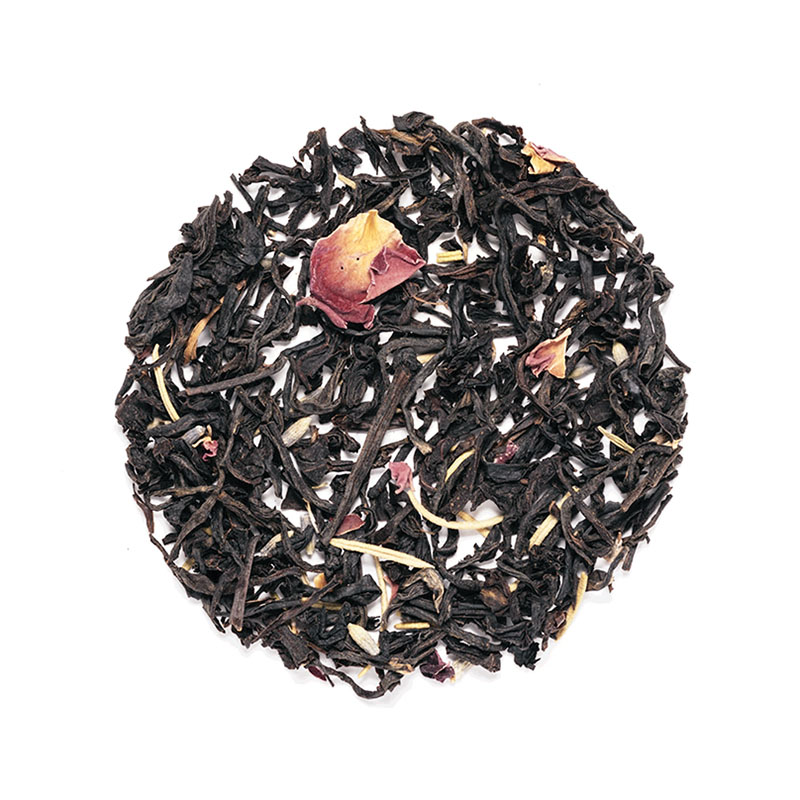
Rose Grey black tea
African Rose Herbal Tea
Smooth, earthy, slightly sweet, floral, pretty and sophisticated blend of red bush herbal tea, beautiful rose petals and safflowers, and just a touch of vanilla to help you unwind and offer you a few moments of calmness while sipping on a gentle tea.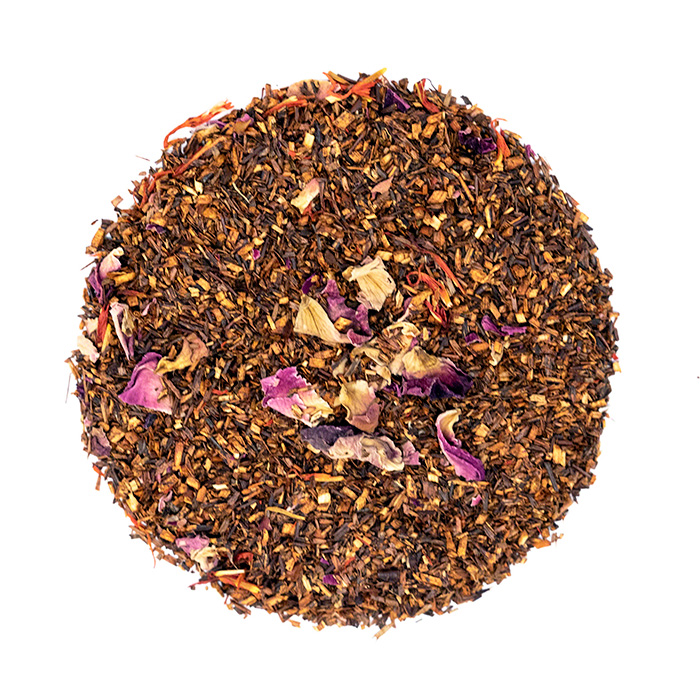
African Rose herbal rooibos tea
Midnight Rose Green & Black Tea Blend
A truly unique blend that combines green tea and black tea with rose petals, vanilla and rose hips for a cup of reminiscent of a dew-soaked morning in a rose garden. [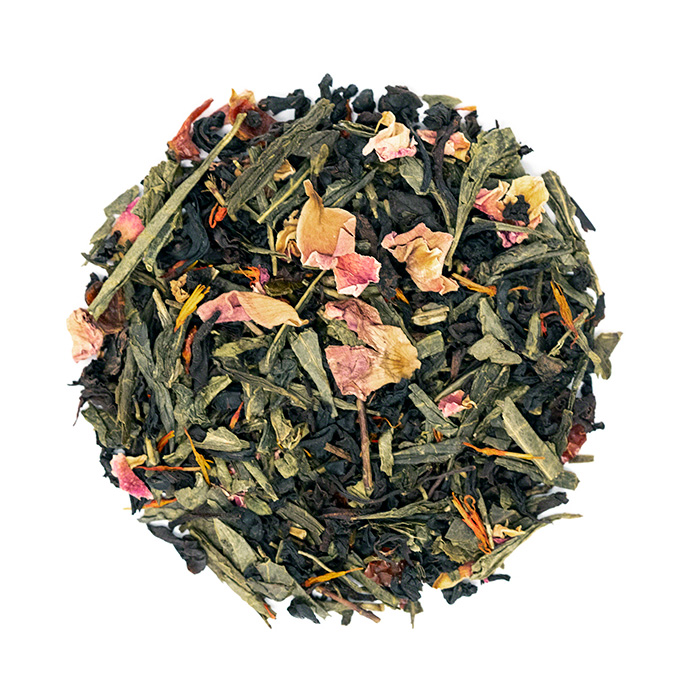
Midnight Rose black and green tea blend
Disclaimer: This article is for informational purposes only. It’s not intended to replace medical advice, diagnosis or treatment. Every person is different and may react to different herbs and teas differently. Never use teas or herbs to treat serious medical conditions on your own. Always seek professional medical advice before choosing home remedies.
References:
[1] https://www.researchgate.net/publication/227635524_Rose_Petal_Tea_as_an_Antioxidant-rich_Beverage_Cultivar_Effects [2] https://www.researchgate.net/publication/227635524_Rose_Petal_Tea_as_an_Antioxidant-rich_Beverage_Cultivar_Effects [3] https://onlinelibrary.wiley.com/doi/abs/10.1111/j.1365-2621.2006.tb12404.x [4] https://pubmed.ncbi.nlm.nih.gov/23627876/ [5] https://www.researchgate.net/publication/227635524_Rose_Petal_Tea_as_an_Antioxidant-rich_Beverage_Cultivar_Effects [6] https://pubmed.ncbi.nlm.nih.gov/23627876/ [7] https://www.ncbi.nlm.nih.gov/pmc/articles/PMC4737971/ [8] https://www.researchgate.net/publication/227635524_Rose_Petal_Tea_as_an_Antioxidant-rich_Beverage_Cultivar_Effects [9] https://www.researchgate.net/publication/331311805_Effects_of_dried_Rose_Petals_Rosa_damascena_on_the_antioxidant_capacity_of_Green_and_Black_Tea [10] https://dergipark.org.tr/tr/download/article-file/398377 [11] https://www.ncbi.nlm.nih.gov/pmc/articles/PMC3586833/ [12] https://www.ncbi.nlm.nih.gov/pmc/articles/PMC3586833/ [13] https://pubmed.ncbi.nlm.nih.gov/16154059/ [14] https://www.ncbi.nlm.nih.gov/pmc/articles/PMC3586833/ [15] https://www.ncbi.nlm.nih.gov/pmc/articles/PMC3757593/
More from:
SLL



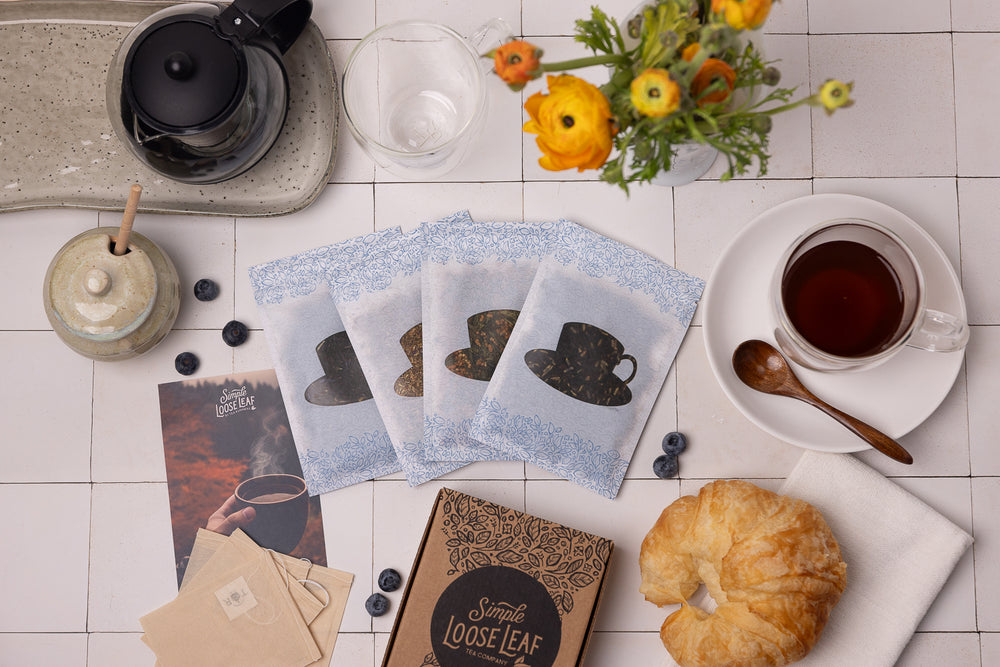

Leave a comment